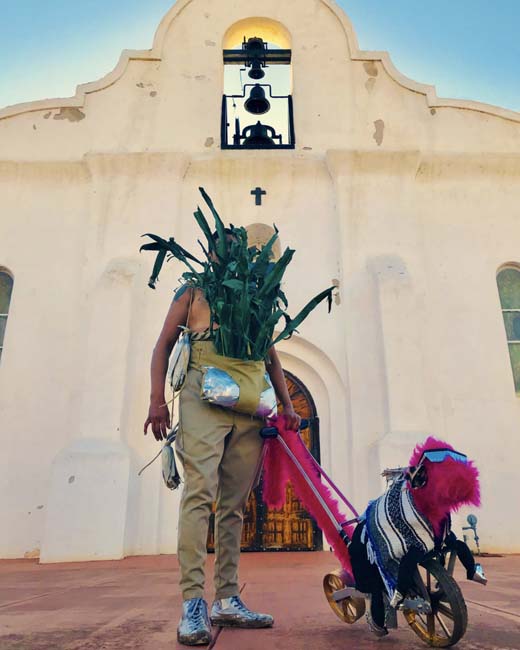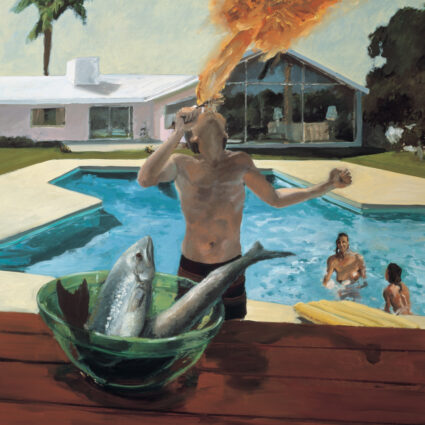JD Pluecker explores the artworks of five artists in the exhibition Soy de Tejas, looking at issues of home and belonging in Texas.

In the photograph, a woman sits, smiling, looking directly into the camera lens. Her silhouette and a cinderblock wall are visible to the left, reflected on the dark screen of a television. Wires dangle behind the woman, and two wood-framed paintings are cut off by the top of the photo: a dancing femme in a slinky dress, the hand of a suited man gripping her. Shoes litter the tiled floor; cups pop up on various surfaces. The arm of the sofa is tattered from use. The window beside her is open, the curtain is knotted to let in air or light. The handle and lock of a door are visible on the right side, in a position that indicates the door is open. I have an uncanny sense of déjà vu looking at this image.
This evocative photo, Norma Villa de Cd. Acuña, COAH, MX (2019), is one of a series titled Women Workers of the Borderlands by San Antonio–based artist Melissa Gamez-Herrera. Gamez-Herrera’s photos make me pause to peer into these scenes of domesticity from just outside of the borders of so-called Texas. I come upon these photos as I walk through Soy de Tejas, an exhibition featuring forty-one Latinx artists with a connection to Texas, curated by Rigoberto Luna at San Antonio’s Centro de Artes in the spring of 2023. As an active curator in San Antonio and across the state, Luna builds on his many years of community-building work and presenting exhibitions at his DIY, artist-run gallery Presa House, which he has operated in collaboration with artist Jenelle Esparza since 2016.
I stop because the photos lead me to consider the edges and outsides of home: the blankets or sheets hung over the windows to keep the heat or the sun out or to provide privacy. The decision to open windows and doors, to create a permeable space. In one photo, I see a vinyl banner on a wall for Familias Unidas, an organization of families that have come together to search for and locate their disappeared family members in Mexico, specifically in the states of Coahuila and Tamaulipas. This poster in an interior space feels especially poignant, an archive of loss inside a home. An insistence on personal remembrance for the family and on collective memory by Gamez-Herrera.
In a show focused on Latinx artists with diverse connections to Texas, these photographs make me slow down as I rethink the premise of the show, this idea of being from somewhere, and specifically being from Texas. These photographs are of homes on the other side of the river in Coahuila. Why include these photos in a show about belonging and Texas?
These photos spur me to reconsider place and belonging in my home state at a time of white supremacist political domination and ever-increasing numbers of hate-driven mass shootings. These shootings and the political system that allows them are evidence of fascist thinking in the state, and fascist thinking is always grounded in a narrow definition of belonging and home tied to blood, borders, and division. I end up asking myself: Who gets to feel safe at home? Who has to leave? Who appears and who disappears? Who is inside and who is outside? How do these boundaries and our own identifications shift over time?
Who gets to feel safe at home? Who has to leave? Who appears and who disappears? Who is inside and who is outside?
I Google Gamez-Herrera’s work on my phone in the gallery, and I find that many of these women are workers in the maquiladoras across the border—women who are organizing independent unions to fight for their rights in factories built by foreign companies. I realize I worked as an interpreter in 2019 for Austin Tan Cerca de la Frontera, an organization dedicated to building cross-border solidarity with independent labor organizations in these cities, so it is no wonder the scenes feel familiar. These shots of their homes become reminders of the women’s efforts to build a sense of peace and comfort, despite the challenges of corporate exploitation and the global neoliberal evisceration of worker power.
Luna’s inclusion of these images in the show suggests that Texas can only be conceived of if we are willing to see it as open to everything the state (and the U.S.) tries so hard to exclude: the workers it needs outside its borders laboring for extremely low wages and the violence the state ignites and inflames through its drug interdictions, white supremacy, weapon exportation, and violent border policing.
I am still meditating on edges, interiors, and exteriors when I come upon an installation by the artist Francis Almendárez. In it, two vintage televisions are perched on pallets used most often for the transport of commercial goods. Cinder blocks are stacked between them, as if to be used to build a future home or suggesting an abandoned project. The wall behind the installation is deep green with roller marks at the edges, indicating a hasty paint job. A light bulb hangs from the ceiling, providing a moody low light for the scene.
In the video on the TV screen to the left, (be)coming home (2019), still images flicker: primarily interior and exterior shots of homes, a sense of home that moves, modifies itself, transmogrifies across geographies, sometimes seeming like Texas and other times California. We see the varieties of barriers erected around homes in one video, graffiti on walls, truck beds, a certain sense of care in the midst of tough times. In the other video, Dinner As I Remember (2016), images of food and dinner tables in unidentified locations fill the screen: plates of primarily Central American dishes and fruits and vegetables. All of these images point to a mobile sense of home. This movement reflects the artist’s life: Almendárez himself comes from a family of intergenerational im/migrants, who have frequently had to relocate due to financial instability. A diaspora of a diaspora of a diaspora.
For each television, there is a pair of headphones for the viewer to become listener as well, to hear the voice of the artist as he reads two different texts that reflect on the sense of home and belonging that arises out of architecture, urban space, and food. The texts are also printed and posted on the wall to the sides of each TV.
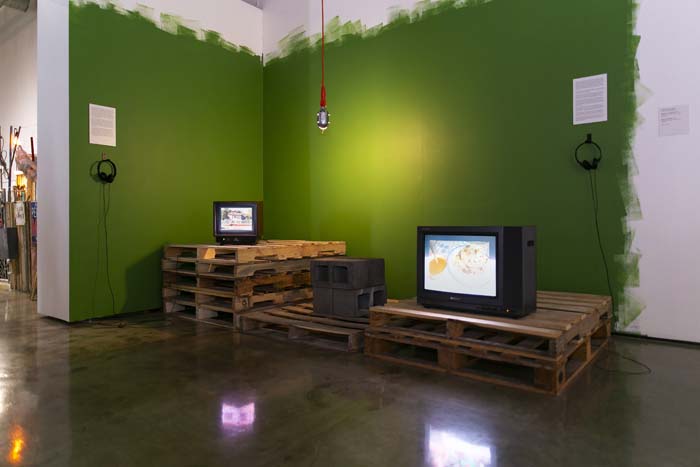
At the end of the text for (be) coming home, Almendárez describes an alternate and expansive sense of “home as open permeable itinerant and metaphysical.” Hearing this formulation, I immediately latch onto these words, as it seems new, different, and unexpected—a sense of home and Texas that is plural and alive, that might no longer be eternally closed, fortress-like, stagnant, and banal.
As I look at Almendárez’s work and listen to his voice, this sense of an itinerant home resonates in my brain across the history of artists and writers in these lands. I can find an itinerant Texas, for example, in the works of writers Gloria Anzaldúa and Pat Parker, who left the state for California to make their own creative lives. Or the sense of home that Lorenzo Thomas brought with him when he came to Houston by way of New York City, the Black Arts Movement, and Panama. This idea of a home that is perpetually shifting and moving is perhaps most clear in his heart-rending poem “Liquid City,” my favorite poem about my native city of Houston.
The contemporary story of the Latinx presence in Texas is typically narrated in hackneyed demographic terms: news stories recently heralded a milestone in Texas that, as the Texas Tribune put it, “Hispanics officially make up the biggest share of Texas’ population.” Anglos have not been the majority in the state for quite some time, but now they are no longer even the biggest group. Despite Latinx people being the largest group in the state, the apartheid political strategies of a small, white Republican elite mean that political power for this largest group or for a coalition of communities of color seems more and more out of reach every day. In addition, an educational system intent on excluding histories of communities of color and LGBTQ+ people means that the schools have become a training ground for fascists and neo-Nazis (some Anglo and also some Latino now) who are lashing out more and more often.
In that gap then, between a Latinx demographic plurality and Anglo political domination and rampant violence, artists are imagining other conceptions of home and belonging. What is it to live in a state where the culture of the majority is Latin American in origin and yet continually faces objectification, oppression, and violence? What is it to live in a state where white supremacist massacres are now being perpetrated by Latinos as well? White supremacy runs that deep.
The work by Gamez-Herrera and Almendárez upends the traditional, hegemonic Anglo conceptions of home and belonging to prioritize openness, permeability, movement, and even the mystical. As I walk through Soy de Tejas and delve deeper, I find other artists in the show whose work resonates with these ideas.
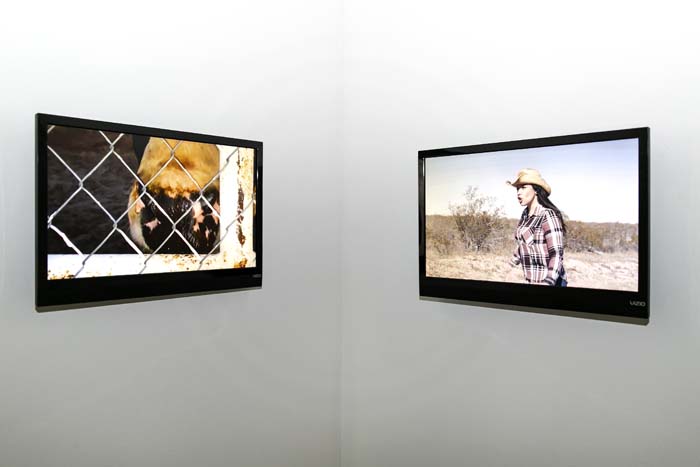
In a dual-channel, one-minute digital video titled Sisters (2023) by Juárez/El Paso–based artist Ingrid Leyva, there are seemingly hundreds of mini-clips that have been fast-cut together, producing a feeling of chaotic energy: a cat licks its body clean; a bonfire crackles; a fish twitches in someone’s hands; human-sized cups twirl on a carnival ride; women walk across a bridge over the Rio Grande; multicolored tassels sway in the wind; two men in charro outfits ride horses through a gas station; a little kid dances in dust; the sun sets over a river; hands braid long brown hair; a snout huffs on the other side of a chain link fence; graffiti flashes on the screen reading “Justicia x Isabel Cabanillas” (a Juárez-based artist killed in 2020); a cartoon-like, hand- drawn animation of Mexican and U.S. flags fluttering in the blue sky above desert mountains; a voice laughs off-screen as a Mexican and U.S. passport dance together; hands knead a spongy masa; a coffee cup fills; Clarice Lispector intones, “Yo me comprendo.” Throughout these fast cuts, we return to a scene of two women in the desert wearing cowboy hats yelling at each other, fighting over whether or not they are actually sisters.
I am transfixed by this depiction of the complicated cross-border lives as lived between Leyva’s two border cities. A chaotic energy builds quickly, as well as a refusal to summarize or synthesize. There is a sense in this video, too, of the permeability of home, its unpredictability, its itineracy, and its perils.
This is an entirely other conception of what home (and Texas) might be.
I find this permeability and the metaphysical nature of rasquachismo in the work of Laredo artist Gil Rocha. I am particularly drawn to his mixed-media installation, titled Otras Fronteras (2022), a fence made of rusted iron bars, old political signs, plastic bags, tape, wires, an ad for Coca-Cola painted over to read “Esto Cala” (This Burns), and chain-link fencing. A door in the middle is barely held shut with scraps of dissected rubber hoses and chicken wire. Tiny bits of glass and plastic are linked together by wire and hold the construction together precariously. Plastic bags full of glass bottles hang from the edge of the fence, and lights are hooked up with long cables. There is humor in the pieces, too: “Se Vende Aire” (Air For Sale) and “Mi Perro Me Mio” (My Dog Peed on Me). I see something in this piece, and the other Rocha pieces in the show, that gestures toward the almost-sacred nature of precarity, a holy art to figuring out how to keep things together by hook or by crook.
I find this spiritual facet of home again in a video performance titled See Unseed (2020) by the artist Vick Quezada. We see the artist returning to the far West Texas landscapes that were the scene of their birth. Like many queer artists of color before them, Quezada made the decision to leave Texas, setting up shop in New England. This video, then, is the scene of their continual returning. In each scene from the video, we find a solitary figure pushing a dog-like contraption on wheels ahead of them as they walk through a variety of landscapes: the Ysleta Mission of El Paso, wide open shots of desert and mountains. The artist plays with foreground, middle ground, and background as the lone figure moves steadily back and forth, in and out of the frame. In a text shown at the beginning of the video, the artist says they returned to their hometown to walk a nine-mile pilgrimage between the three Spanish Catholic missions established along the border in the southeastern reaches of what is now El Paso. Ornamented with corn husks and chain-link fencing, Quezada operated a manual corn seeder along the way, scattering maize seeds as they walked.
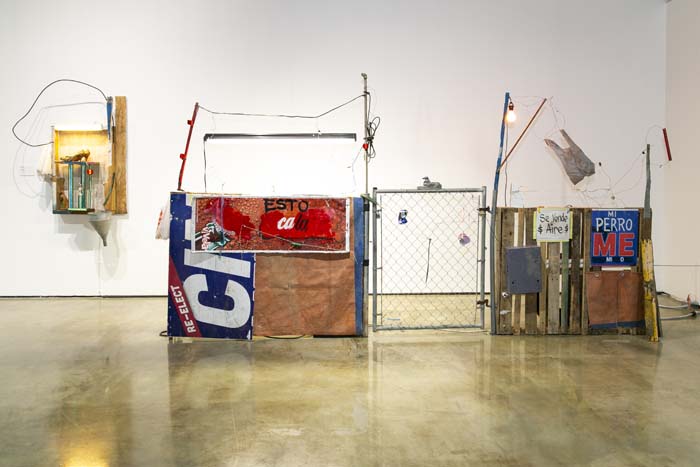
As I snap photos of all these artists’ work, my mind gets to wandering. Home exists both in the material and outside the bounds of the material, a kind of electric current or fluvial current running through, in, and around the people who inhabit it. A version of home and belonging that rejects the static or an imagined stability. A sense of belonging that does not suffocate or depend on the exclusion of imagined Others.
This is an entirely other conception of what home (and Texas) might be. A dream of a home outside of white nativism and nationalism. Far from the nightmare of home as closed and armored, the castle with a camera at all doors and a high fence around it, no entry points unmonitored; the nightmare of a home as impermeable—nothing comes in and nothing comes out, with loaded guns to back it all up; home as defended by a moat with a wall, barbed wire, and Greg Abbott’s horrible floating buoys in the river to prevent unpermitted entries.
As the writer Dionne Brand has put it, “Home suggests order and routine, tradition, family. Someone else’s order struck me as fascinating—truthfully, suffocating… It was as if they said there was no more about the world to happen, no more to know.” As I walk out of the air-conditioned halls of the Centro de Artes and into the broiling, sun-soaked summer air, I reflect on these artists—each with their own complicated relationship to Texas—and how their work insists that there is much more about the world that is happening and will happen, much more to get to know.
